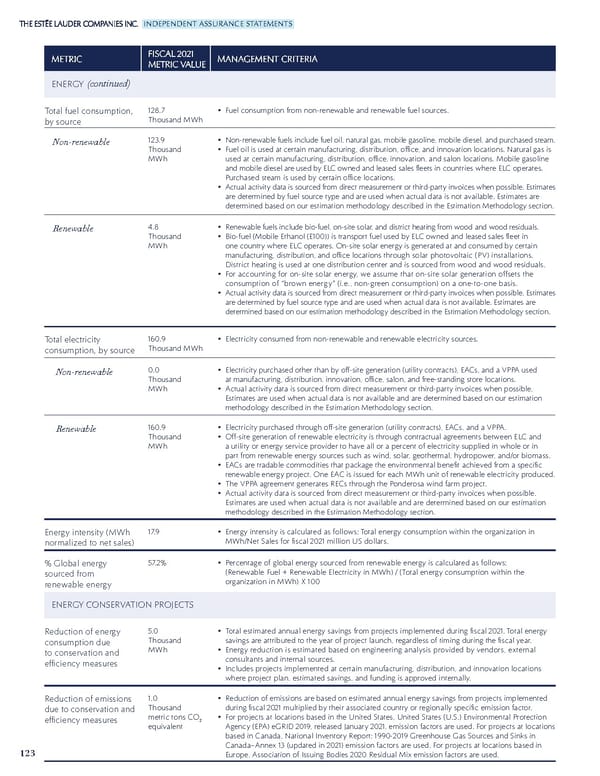123 INDEPENDENT ASSURANCE STATEMENTS METRIC METRIC FISCAL 2021 FISCAL 2021 METRIC VALUE METRIC VALUE MANAGEMENT CRITERIA MANAGEMENT CRITERIA ENERGY Total fuel consumption, by source 128.7 Thousand MWh • Fuel consumption from non-renewable and renewable fuel sources. Non-renewable 1 23.9 Thousand MWh • Non-renewable fuels include fuel oil, natural gas, mobile gasoline, mobile diesel, and purchased steam. • Fuel oil is used at certain manufacturing, distribution, office, and innovation locations. Natural gas is used at certain manufacturing, distribution, office, innovation, and salon locations. Mobile gasoline and mobile diesel are used by ELC owned and leased sales fleets in countries where ELC operates. Purchased steam is used by certain office locations. • Actual activity data is sourced from direct measurement or third-party invoices when possible. Estimates are determined by fuel source type and are used when actual data is not available. Estimates are determined based on our estimation methodology described in the Estimation Methodology section. Renewable 4.8 Thousand MWh • Renewable fuels include bio-fuel, on-site solar, and district heating from wood and wood residuals. • Bio-fuel (Mobile Ethanol (E100)) is transport fuel used by ELC owned and leased sales fleet in one country where ELC operates. On-site solar energy is generated at and consumed by certain manufacturing, distribution, and office locations through solar photovoltaic (PV) installations. District heating is used at one distribution center and is sourced from wood and wood residuals. • For accounting for on-site solar energy, we assume that on-site solar generation offsets the consumption of “brown energy” (i.e., non-green consumption) on a one-to-one basis. • Actual activity data is sourced from direct measurement or third-party invoices when possible. Estimates are determined by fuel source type and are used when actual data is not available. Estimates are determined based on our estimation methodology described in the Estimation Methodology section. Total electricity consumption, by source 160.9 Thousand MWh • Electricity consumed from non-renewable and renewable electricity sources. Non-renewable 0.0 Thousand MWh • Electricity purchased other than by off-site generation (utility contracts), EACs, and a VPPA used at manufacturing, distribution, innovation, office, salon, and free-standing store locations. • Actual activity data is sourced from direct measurement or third-party invoices when possible. Estimates are used when actual data is not available and are determined based on our estimation methodology described in the Estimation Methodology section. Renewable 160.9 Thousand MWh • Electricity purchased through off-site generation (utility contracts), EACs, and a VPPA. • Off-site generation of renewable electricity is through contractual agreements between ELC and a utility or energy service provider to have all or a percent of electricity supplied in whole or in part from renewable energy sources such as wind, solar, geothermal, hydropower, and/or biomass. • EACs are tradable commodities that package the environmental benefit achieved from a specific renewable energy project. One EAC is issued for each MWh unit of renewable electricity produced. • The VPPA agreement generates RECs through the Ponderosa wind farm project. • Actual activity data is sourced from direct measurement or third-party invoices when possible. Estimates are used when actual data is not available and are determined based on our estimation methodology described in the Estimation Methodology section. Energy intensity (MWh normalized to net sales) 1 7.9 • Energy intensity is calculated as follows: Total energy consumption within the organization in MWh/Net Sales for fiscal 2021 million US dollars. % Global energy sourced from renewable energy 57.2% • Percentage of global energy sourced from renewable energy is calculated as follows: (Renewable Fuel + Renewable Electricity in MWh) / (Total energy consumption within the organization in MWh) X 100 ENERGY CONSERVATION PROJECTS Reduction of energy consumption due to conservation and efficiency measures 5.0 Thousand MWh • Total estimated annual energy savings from projects implemented during fiscal 2021. Total energy savings are attributed to the year of project launch, regardless of timing during the fiscal year. • Energy reduction is estimated based on engineering analysis provided by vendors, external consultants and internal sources. • Includes projects implemented at certain manufacturing, distribution, and innovation locations where project plan, estimated savings, and funding is approved internally. Reduction of emissions due to conservation and efficiency measures 1.0 Thousand metric tons CO 2 equivalent • Reduction of emissions are based on estimated annual energy savings from projects implemented during fiscal 2021 multiplied by their associated country or regionally specific emission factor. • For projects at locations based in the United States, United States (U.S.) Environmental Protection Agency (EPA) eGRID 2019, released January 2021, emission factors are used. For projects at locations based in Canada, National Inventory Report: 1990-2019 Greenhouse Gas Sources and Sinks in Canada– Annex 13 (updated in 2021) emission factors are used. For projects at locations based in Europe, Association of Issuing Bodies 2020 Residual Mix emission factors are used. ( continued)
 Estee Lauder Companies Sustainability Report Page 123 Page 125
Estee Lauder Companies Sustainability Report Page 123 Page 125